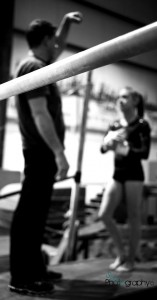Training is not about the hurt or pain; it is not about puking and being at the max in each workout. That is not training.
Training must be systematic, sequential and progressive; it should incorporate hard workouts and easy workouts to allow the body to adapt.
Work is easy training is hard.
Anyone can do mindless work that wears out the body; not very many can focus and put the pieces together to systematically improve gymnastics performance over time.
 To understand what good training is, it is important to be able to separate fact from fiction and style and marketing claims from programs that have substance and produce consistent results. I have seen too many coaches approach training like an ADHD kid in a candy store. Switching thoughts and plans all too often to see if one was really working. They hear a coach talking about the “Insanity Workout” and the results they have had and decide to jump in to that. Only to start a YOGA workout 2 weeks later. Along the same line of thought beware of false prophets bearing gifts. Nothing easily attained is ever worthwhile and nothing worthwhile is easily attained. Focus on fundamentals and build on the basics. Good training is built upon scientific laws, empirical evidence and best practices that has stood the test of time. Adaptation takes time; the process is predictable based on the demands imposed on the body. Nothing exotic here, it is all very basic, if someone tells you otherwise, don’t listen. Take your time and stay on the functional path to the destination – optimum performance in the competitive arena.
To understand what good training is, it is important to be able to separate fact from fiction and style and marketing claims from programs that have substance and produce consistent results. I have seen too many coaches approach training like an ADHD kid in a candy store. Switching thoughts and plans all too often to see if one was really working. They hear a coach talking about the “Insanity Workout” and the results they have had and decide to jump in to that. Only to start a YOGA workout 2 weeks later. Along the same line of thought beware of false prophets bearing gifts. Nothing easily attained is ever worthwhile and nothing worthwhile is easily attained. Focus on fundamentals and build on the basics. Good training is built upon scientific laws, empirical evidence and best practices that has stood the test of time. Adaptation takes time; the process is predictable based on the demands imposed on the body. Nothing exotic here, it is all very basic, if someone tells you otherwise, don’t listen. Take your time and stay on the functional path to the destination – optimum performance in the competitive arena.
Sometimes things need to change.
Everyone likes to think of innovation and change as major things you have to do. A Radical departure from what you have been doing. I like think of change as a constant, if you are not continually changing and adapting then you are not growing. The same with innovation, it is an ongoing process. If you want to stay ahead of the competition then change and innovation needs to part of your daily routine. You have to see your world with different eyes. You have to use all your senses and heighten your powers of observation.
The opportunities for change and innovation are often right before our eyes and we do not see them because we are too busy repeating what we have done before. Change starts with daily evaluation and self-reflection. Make that part of your daily coaching process to give yourself an opportunity to change. You don’t change and innovate by just copying others, rather learn from others and go beyond what they have done. Your athletes are changing and adapting everyday, why not you the coach?
To paraphrase Gandhi you must be the change or innovation you want to be. So lead change, don’t follow and make change and innovation a habit.
Like anything else in the gym, you need a plan. Even for change.
Just saw this on Rick McCharles Site, Gymnastics Coaching.com
I visit 40-50 gyms a year. Within 60 seconds I get a pretty accurate first impression. John Geddert shares his ideas on changing the “culture” of a Gymnastics Club: …
READ MORE FROM JOHN GEDDERT’S BLOG